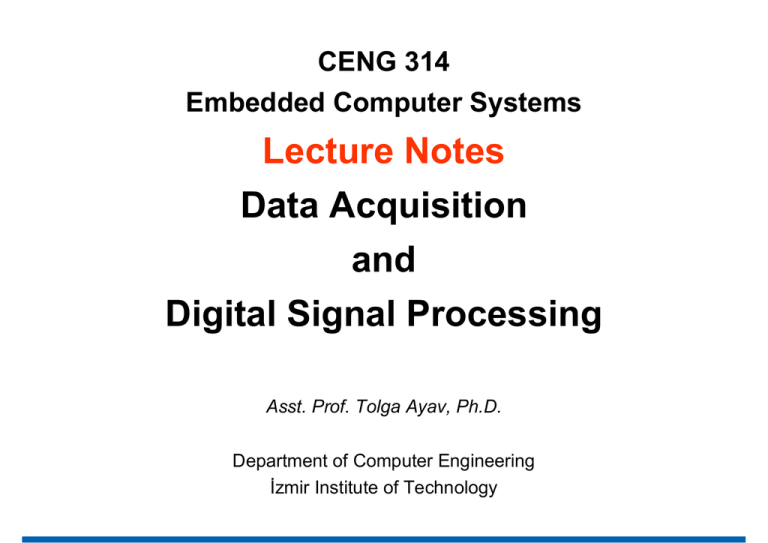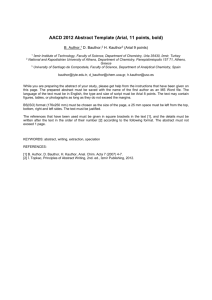Lecture Notes Data Acquisition and Digital Signal Processing
advertisement

CENG 314 Embedded Computer Systems Lecture Notes Data Acquisition and Digital Signal Processing Asst. Prof. Tolga Ayav, Ph.D. Department of Computer Engineering İzmir Institute of Technology Data Acquisition Data acquisition is the sampling of the real world to generate data that can be manipulated by a computer. Sometimes abbreviated DAQ or DAS, data acquisition typically involves acquisition of signals and waveforms and processing the signals to obtain desired information. The components of data acquisition systems include appropriate sensors that convert any measurement parameter to an electrical signal, which is acquired by data acquisition hardware. İzmir Institute of Technology Embedded Systems Lab Data Acquisition İzmir Institute of Technology Embedded Systems Lab Data Acquisition and Control Physical systems (real-world phenomena) zTransducers and Actuators zSignal Conditioning equipment zData Acquisition & Control Hardware zSoftware z İzmir Institute of Technology Embedded Systems Lab Analog-to-Digital Conversion Analog-to-digital conversion (ADC) and digital-toanalog conversion (DAC) are the processes that allow digital computers to interact with everyday signals: voltage, current, distance, velocity, temperature, altitude, force, acceleration, pressure etc. Digital information is different from its analog counterpart in two respects: - it is sampled - it is quantized İzmir Institute of Technology Embedded Systems Lab ADC Principles: S/H and Quantization İzmir Institute of Technology Embedded Systems Lab Quantization Error İzmir Institute of Technology Embedded Systems Lab Analog-to-Digital Conversion İzmir Institute of Technology Embedded Systems Lab Sampling Theory Nyquist theorem: Analog signal that has been digitized can be perfectly reconstructed if the sampling rate was 1/(2W) seconds, where W is the highest frequency in the original signal. İzmir Institute of Technology Embedded Systems Lab Sampling Theory Aliasing ! İzmir Institute of Technology Embedded Systems Lab Using Analog Filters İzmir Institute of Technology Embedded Systems Lab Basic A/D Architecture ADC Types: z z z Flash ADC Succesive-approximation ADC Sigma-delta ADC İzmir Institute of Technology Embedded Systems Lab Flash ADC • Requires 4095 parallel comparators for 12-bit. • Very fast, conversion is done in one step. • Complexity doubles with each added bit of resolution. İzmir Institute of Technology Embedded Systems Lab Succesive-approximation ADC z z z Uses an internal n-bit DAC Conversion logic is a simple n-bit counter N-bit ADC requires 2^n cycles to perform a conversion in worst case. İzmir Institute of Technology Embedded Systems Lab Delta-sigma ADC • Requires 1-bit DAC: less susceptible to noise • Requires high sampling rate, suitable for audio applications • It has digital filter, so no need for expensive low-pass filters at input • Resolution can be very high. İzmir Institute of Technology Embedded Systems Lab Digital-to-Analog Converter (DAC) İzmir Institute of Technology Embedded Systems Lab Transducers • Converts physical properties such as temperature, pressure, force etc. to electrical signals. Pt-100 thermocouple İzmir Institute of Technology Embedded Systems Lab Signal Conditioning Signal Input signal from sensor Conditioning z z z z z z İzmir Institute of Technology to A/D or data Acquisition equipment Amplifying Scaling Offsetting Filtering Linearization Isolation Embedded Systems Lab Digital Signal Processing 1) Specialized microprocessors (DSP) 2) Digital Signal Controllers (DSC) 3) FPGA, ASIC 4) Powerful general purpose microprocessors İzmir Institute of Technology Embedded Systems Lab Example: Digital Filters Example: FIR filter with 4 coefficients • Reproducable response • Temperature insensitive • Programmable İzmir Institute of Technology • Unable to pass power • Requires a power supply • Frequency range limitations Embedded Systems Lab Case Study Ambient Temperature: 0-120 C Amplifier Scaling Ain MCU +-5 volt analog İnput range 12-bit resolution N-Type Thermocouple EMI disturbance Getting the most from an ADC means scaling the maximum signal from each sensor to match the maximum input of the ADC. Therefore, we have to use an amplifier along with a scaling circuit. We may left the noise filtering on the acquired temperature to the program. İzmir Institute of Technology Embedded Systems Lab Table for Thermocouple Take these twelve points to construct a look-up table in the microcontroller İzmir Institute of Technology Embedded Systems Lab Linear Interpolation Calculate the output of N-type thermocouple at 3 °C. We will use two points: (0, 0) and (10, 0.261). f(3)=0+(3-0)(0.261-0)/(10-0)=0.0783 (In the table, f(3) is given as 0.078) İzmir Institute of Technology Embedded Systems Lab Programmable Gain Amplifier Typically, PGAs are designed in two varieties: powers of two (G = 1,2,4,...) and powers of ten (G = 1,10,100,...). Let's piece one together for gains of 1,2,4 and 8. What resistor collection provides these gains? One solution is: R1 = 2 kΩ, R2 = 1 kΩ, R3 = 500 Ω and R4 = 500 Ω. This pattern can be extended to any number of gain ranges. İzmir Institute of Technology Embedded Systems Lab Digital Filtering z A very simple FIR filter (moving average filter) attenuating the high frequencies: İzmir Institute of Technology Embedded Systems Lab A Solution z z z z z Amplify the signal such that the output of the signal is approximately 10 volts at 120 C. Shift the signal 5 volts downwards. Implement a look-up table in the microcontroller Implement a digital Low Pass Filter to reduce EMI disturbance. Assume that ADC take the following samples (Sampling rate is 10 ms): − z (2.81v, 2.94v, 2.68v, 2.56v, 2.78v, 2.12v, 2.48v, ...) What would be the current temperature according to your design? İzmir Institute of Technology Embedded Systems Lab



